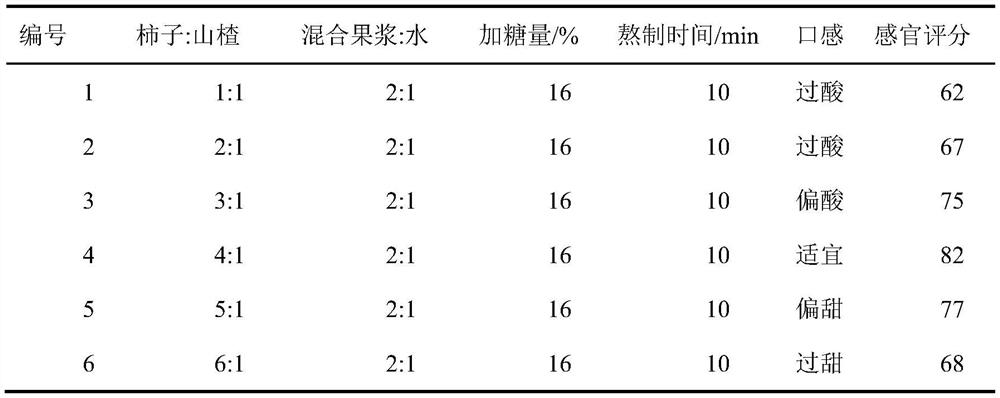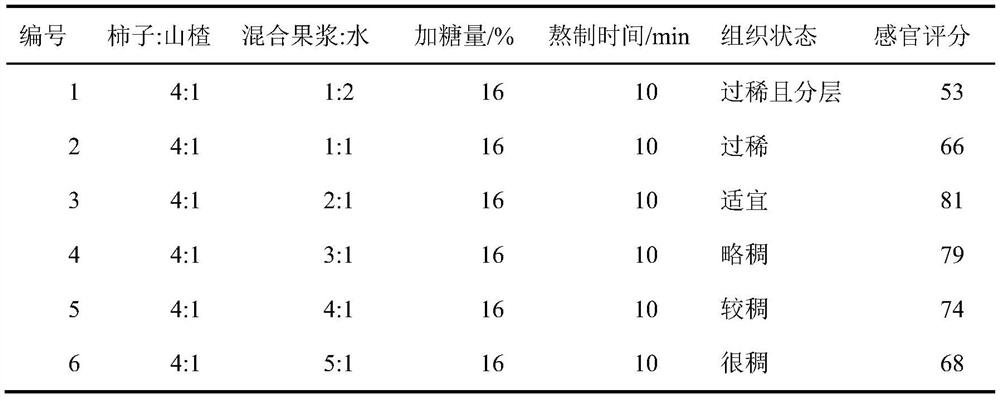A kind of persimmon hawthorn jam and preparation method thereof
A technology for hawthorn jam and persimmon is applied in the directions of bacteria used in food preparation, food ingredients as emulsifiers, food ingredients as antioxidants, etc. Group, not easy to stick, good sensory quality effect
- Summary
- Abstract
- Description
- Claims
- Application Information
AI Technical Summary
Problems solved by technology
Method used
Image
Examples
Embodiment 1
[0042] Example 1 Optimization of process conditions for persimmon and hawthorn jam
[0043] The persimmon variety is Gongcheng Yueshi, and the fully ripe persimmon fruit is selected, and the hawthorn variety selected is Dajinxing.
[0044] Select the mass ratio of persimmon pulp and hawthorn pulp to be 1:1, 2:1, 3:1, 4:1, 5:1, 6:1 respectively, and the fixed total amount is 200g. Add 100g of water, add 20% white After granulated sugar, heat for 10 minutes, and use the sensory score as an index to optimize the optimal ratio of persimmon: hawthorn. The mass ratio of fruit pulp and water is selected as 1:1, 2:1, 3:1, 4:1, 5:1, 6:1 respectively, and the fixed total amount is 300g, wherein mixed persimmon pulp and hawthorn pulp are combined The ratio is 4:1, adding 20% white granulated sugar and heating for 10 minutes, using the sensory score as an index, the optimal ratio of mixed fruit pulp and water is optimized. The amount of white granulated sugar added is 8%, 12%, 16%, 20...
Embodiment 2
[0062] Example 2 The color protection of persimmon hawthorn jam
[0063] Three kinds of color-protecting agents are selected to protect the color of the persimmon and hawthorn pulp, and these three kinds of color-protecting agents are sodium D-isoascorbate, tea polyphenol and disodium EDTA respectively. Taking L*, a*, and b* as indicators, the single factor test on the dosage of the three color-protecting agents shows that the dosage of sodium D-isoascorbate is 0.14%-0.42%, and the dosage of tea polyphenols is 0.022‰-0.066‰ , The dosage of disodium EDTA is 0.014‰-0.042‰. According to the single factor results, an orthogonal experiment was designed, and the compounding of the color-protecting agent was carried out with L*, a*, and b* as indexes. The factors and levels of the orthogonal design are shown in Table 7 below.
[0064] Table 7 Compounding Table of Color Protecting Agent
[0065]
[0066] Table 8 Results of compounding test of color-protecting agent
[0067] ...
Embodiment 3
[0070] Example 3 Coloring of persimmon and hawthorn jam
[0071] The natural pigment β-carotene is used to color the jam, and it is added before the pulp is boiled. Place it at room temperature for 2 days, and perform sensory evaluation. The results are shown in Table 9.
[0072] Table 9 Results of toning test
[0073]
[0074] From the results of the coloring test, it can be seen that with the increase of the amount of β-carotene, the color of persimmon and hawthorn jam gradually deepens, and the score of the jam first increases and then decreases. When the amount of β-carotene is 0.10%, the score of the jam increases. The highest, so the final selection of β-carotene addition is 0.10%.
PUM
 Login to View More
Login to View More Abstract
Description
Claims
Application Information
 Login to View More
Login to View More - R&D
- Intellectual Property
- Life Sciences
- Materials
- Tech Scout
- Unparalleled Data Quality
- Higher Quality Content
- 60% Fewer Hallucinations
Browse by: Latest US Patents, China's latest patents, Technical Efficacy Thesaurus, Application Domain, Technology Topic, Popular Technical Reports.
© 2025 PatSnap. All rights reserved.Legal|Privacy policy|Modern Slavery Act Transparency Statement|Sitemap|About US| Contact US: help@patsnap.com



